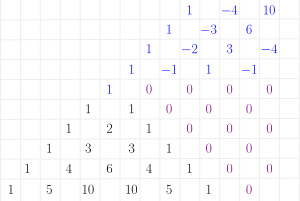Pascal's Triangle: Difference between revisions
From wikiluntti
| Line 29: | Line 29: | ||
The coefficients of binomial expansion can be easily seen from the Pascal triangle. The number is a sum of the two numbers above it. | The coefficients of binomial expansion can be easily seen from the Pascal triangle. The number is a sum of the two numbers above it. | ||
=== Pascal's triangle: Negative | === Pascal's triangle: Negative right === | ||
This can be extended to negative numbers easily. | This can be extended to negative numbers easily. | ||
| Line 51: | Line 51: | ||
* https://www.wolframalpha.com/input?i=series%28+%281%2Bx%29%5E%28-2%29+%29 | * https://www.wolframalpha.com/input?i=series%28+%281%2Bx%29%5E%28-2%29+%29 | ||
* https://www.wolframalpha.com/input?i=series%28+%281%2Bx%29%5E%28-3%29+%29 | * https://www.wolframalpha.com/input?i=series%28+%281%2Bx%29%5E%28-3%29+%29 | ||
=== Pascal's triangle: Negative left === | |||
The triangle can be extended to the left also. | |||
Revision as of 19:10, 19 October 2022
Introduction
Binomial expansion
Pascal's triangle

The coefficients of binomial expansion can be easily seen from the Pascal triangle. The number is a sum of the two numbers above it.
Pascal's triangle: Negative right
This can be extended to negative numbers easily.

Now, instead of expanding , we will use , where is a negative integer. The exponent of each terms grows when going to left. We get according to the Pascal triangle
And by Taylor series (expansion at Laurent series) we get
- https://www.wolframalpha.com/input?i=series%28+%281%2Bx%29%5E%28-1%29+%29
- https://www.wolframalpha.com/input?i=series%28+%281%2Bx%29%5E%28-2%29+%29
- https://www.wolframalpha.com/input?i=series%28+%281%2Bx%29%5E%28-3%29+%29
Pascal's triangle: Negative left
The triangle can be extended to the left also.





